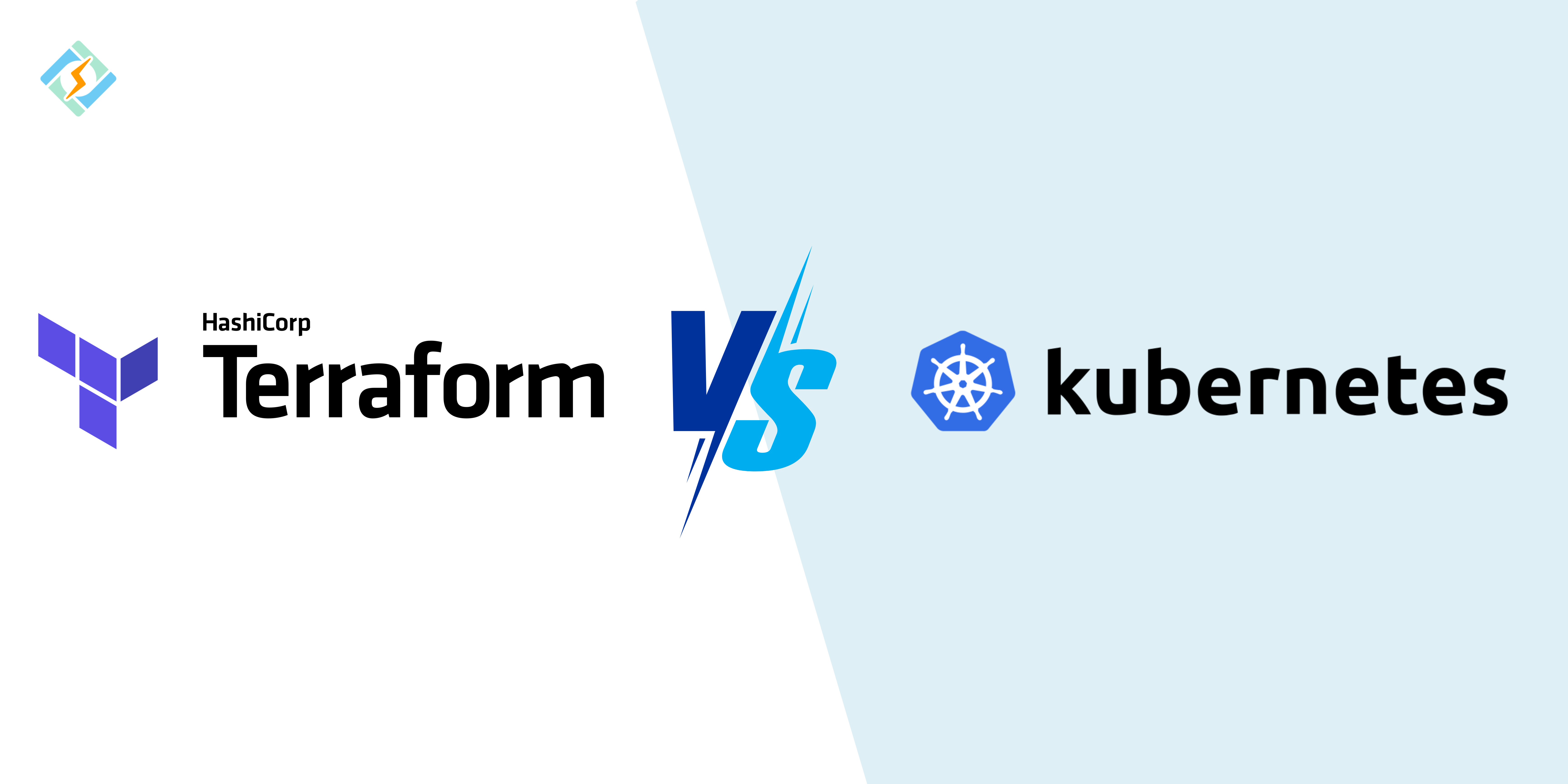In the modern IT environment, DevOps and cloud infrastructure play an important role, which is why tools and platforms that can compliment them are extremely important. Terraform and Kubernetes are two such powerful tools that serve different yet complementary purposes.
Understanding the differences and similarities between Terraform vs Kuberentes is important for the right application. While Terraform is best for infrastructure provisioning, Kubeneretes is the obvious choice for containerized workloads.
In this guide, we shall discuss the differences, similarities, and use cases for Terraform vs Kubernetes.
What is Terraform?
Terraform is an open-source Infrastructure as a Code tool by HashiCorp. It helps users define, provision, and manage infrastructure using HCL (HashiCorp Configuration Language). Terraform automates deployment across cloud providers, such as Google Cloud, AWS, and Azure.
Key Features of Terraform
- Simple human-readable configuration file for automated and repeatable deployments.
- Multi-cloud support.
- Maintains a state file that tracks the current infrastructure for consistency.
- New resource creation that reduces configuration drift and ensures reliability.
- Supports reusable modules, making the infrastructure efficient and maintainable.
- Automatically manages dependency between infrastructure components.
- Work seamlessly with Git.
- Facilitates rapid scaling without manual intervention.
| Pros | Cons |
| Multi-Cloud Support: Can manage infrastructure across various cloud providers like AWS, Azure, and GCP. | Learning Curve: The initial learning curve may be steep for beginners due to HCL and complex configurations. |
| Declarative Configuration: Simplifies infrastructure management by defining resources in human-readable configuration files. | State Management: Handling the state file can be challenging in large or complex infrastructures. |
| Infrastructure as Code: Enables version control for infrastructure, ensuring repeatable and consistent deployments. | Limited to Infrastructure: Primarily focused on infrastructure management, not suited for application-level automation or orchestration. |
| Modularity: Supports reusable modules, making it easier to manage and scale infrastructure. | Provider Limitations: Some cloud providers may not have full support for all services or may require additional workarounds. |
| Automation & Scalability: Can automate provisioning and scaling of infrastructure, reducing manual intervention. | State File Conflicts: In a team environment, managing the state file can lead to conflicts and inconsistencies if not handled carefully. |
| Strong Community Support: Terraform has a large, active community and extensive documentation to help troubleshoot issues. | Slow Execution for Large Deployments: With large-scale infrastructure, Terraform can sometimes be slower in execution compared to other tools like Ansible. |
| Open-Source with Enterprise Support: Terraform is free to use with an optional enterprise version for advanced features and support. | Limited on Dynamic Resources: For complex dynamic resources or workflows, Terraform might not be as efficient as some alternative tools. |
What is Kubernetes?
Kubernetes also known as K8s is an open-source container orchestration platform to automate different processes of the development cycle. Kubernetes is widely used in cloud-native environments to ensure efficient and reliable container management.
Get exclusive access to all things tech-savvy, and be the first to receive
the latest updates directly in your inbox.
Key Features of Kubernetes
- Ensures seamless deployment and scaling of container-based applications.
- Automatically restarted failed containers.
- Distributes traffic evenly.
- Allows application updates without downtime.
- Can be used on cloud and on-premises.
- Efficiently manages CPU, memory, and storage allocation.
- Supports plugins and third party tools.
- Provides built-in networking policies, secrets management, and RBAC (Role-Based Access Control) for enhanced security.
Related Article: Kubernetes Secrets – How To Use, Create, & Manage Them Effectively
| Pros | Cons |
| Automated Scaling – Adjusts resources dynamically based on demand, improving efficiency. | Steep Learning Curve – Requires in-depth knowledge to set up and manage effectively. |
| Self-Healing – Automatically replaces failed containers and ensures system stability. | Complex Setup – Installation and configuration can be challenging, especially for beginners. |
| Multi-Cloud & Hybrid Support – Can be deployed on any cloud provider or on-premises. | High Resource Consumption – Requires significant computing resources, which can be costly. |
| Rolling Updates & Rollbacks – Enables smooth updates and quick rollbacks without downtime. | Networking Complexity – Managing networking and service discovery requires additional expertise. |
| Load Balancing & Service Discovery – Efficiently distributes traffic and manages service-to-service communication. | Storage Management – Managing persistent storage for stateful applications can be complex. |
| Declarative Configuration – Uses YAML manifests for infrastructure automation and version control. | Security Configuration Overhead – Requires careful configuration of security policies, RBAC, and access controls. |
| Extensibility – Supports plugins, third-party integrations, and custom controllers. | Challenging Debugging & Monitoring – Troubleshooting and monitoring distributed applications require additional tools. |
| Community & Ecosystem Support – Large open-source community with extensive documentation and tools. | Cost of Maintenance – Requires skilled personnel and dedicated resources for ongoing maintenance. |
Terraform Vs Kubernetes – Main Differences
| Feature | Terraform | Kubernetes |
| Purpose | Infrastructure as Code (IaC) for provisioning and managing infrastructure. | Container orchestration for deploying, scaling, and managing containerized applications. |
| Primary Use Case | Automating cloud infrastructure deployment across multiple providers. | Managing containerized applications in a cluster environment. |
| Configuration Style | Declarative (HCL – HashiCorp Configuration Language). | Declarative (YAML manifests). |
| Scope | Infrastructure management (VMs, networks, databases, storage). | Application lifecycle management (containers, pods, services). |
| State Management | Uses a state file to track infrastructure changes. | Maintains the desired state of applications within the cluster. |
| Provisioning Model | Creates, updates, and destroys resources based on configuration. | Schedules and manages containers, ensuring they run efficiently. |
| Multi-Cloud Support | Yes – Works with AWS, Azure, GCP, and on-premises. | Yes – Can be deployed on cloud platforms and on-premises environments. |
| Scalability | Scales infrastructure (e.g., VMs, databases, networking components). | Scales applications dynamically by adjusting container replicas. |
| Self-Healing | No built-in self-healing (relies on infrastructure redundancy). | Yes – Automatically restarts failed containers and replaces unhealthy nodes. |
| Networking | Manages cloud networking components (VPCs, subnets, firewalls). | Handles container networking and service discovery. |
| Storage Management | Provisions cloud storage resources (e.g., S3, EBS, Google Cloud Storage). | Manages persistent storage volumes for containerized applications. |
| Automation & Extensibility | Uses modules for reusable infrastructure components. | Supports plugins, operators, and custom controllers for extended functionality. |
| Complexity | Easier to learn but requires knowledge of cloud providers and infrastructure. | More complex, requiring expertise in container orchestration and networking. |
| Community & Ecosystem | Strong community, widely used in DevOps and infrastructure automation. | Large open-source community with extensive tooling and integrations. |
When to use Terraform with Kubernetes
Sometimes it is best to use both together to automate infrastructure provisioning while managing applications. Here are a few use cases:
- Provisioning Kubernetes Clusters – Terraform can automate the deployment of Kubernetes clusters on AWS (EKS), Azure (AKS), GCP (GKE), or on-prem.
- Managing Cloud Infrastructure for Kubernetes – Terraform handles networking (VPCs, subnets), storage (EBS, S3), and security (IAM roles) needed for Kubernetes clusters.
- Scaling Infrastructure Alongside Kubernetes – Automate cluster node scaling, load balancers, and persistent storage provisioning.
- Multi-Cloud Kubernetes Deployments – Use Terraform to ensure a consistent Kubernetes setup across different cloud providers.
- Simplifying CI/CD Pipelines – Automate Kubernetes resource deployment alongside infrastructure in DevOps workflows.
- Ensuring Infrastructure as Code (IaC) – Maintain a version-controlled, repeatable infrastructure setup for Kubernetes.
Wrapping Up – Terraform vs Kubernetes
It is important to understand the functions that both of these tools offer and use them effectively. This guide helps you draw the differences between the two and leverage them fully!
Frequently Asked Questions
1. What is the main difference between Terraform Vs Kubernetes?
Terraform is an Infrastructure as Code (IaC) tool used for provisioning and managing cloud resources, while Kubernetes is a container orchestration platform for managing and scaling containerized applications.
2. Can Terraform and Kubernetes be used together?
Yes, Terraform can be used to provision Kubernetes clusters on cloud platforms like AWS, Azure, and GCP, ensuring automated infrastructure setup.
3. When should I use Kubernetes instead of Terraform?
Use Kubernetes when you need to deploy, scale, and manage containerized applications, ensuring efficient workload orchestration.




